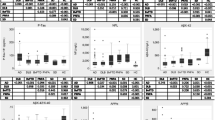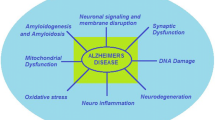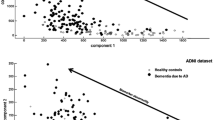Abstract
Pathobiological factors underlying phenotypic diversity in Alzheimer’s disease (AD) are incompletely understood. We used an extended cerebrospinal fluid (CSF) panel to explore differences between “typical” with “atypical” AD and between amnestic, posterior cortical atrophy, logopenic aphasia and frontal variants. We included 97 subjects fulfilling International Working Group-2 research criteria for AD of whom 61 had “typical” AD and 36 “atypical” syndromes, and 30 controls. CSF biomarkers included total tau (T-tau), phosphorylated tau (P-tau), amyloid β1-42, amyloid βX-38/40/42, YKL-40, neurofilament light (NFL), and amyloid precursor proteins α and β. The typical and atypical groups were matched for age, sex, severity and rate of cognitive decline and had similar biomarker profiles, with the exception of NFL which was higher in the atypical group (p = 0.03). Sub-classifying the atypical group into its constituent clinical syndromes, posterior cortical atrophy was associated with the lowest T-tau [604.4 (436.8–675.8) pg/mL], P-tau (79.8 ± 21.8 pg/L), T-tau/Aβ1-42 ratio [2.3 (1.4–2.6)], AβX-40/X-42 ratio (22.1 ± 5.8) and rate of cognitive decline [1.9 (0.75–4.25) MMSE points/year]. Conversely, the frontal variant group had the highest levels of T-tau [1185.4 (591.7–1329.3) pg/mL], P-tau (116.4 ± 45.4 pg/L), T-tau/Aβ1-42 ratio [5.2 (3.3–6.9)] and AβX-40/X-42 ratio (27.9 ± 7.5), and rate of cognitive decline. Whilst on a group level IWG-2 “typical” and “atypical” AD share similar CSF profiles, which are very different from controls, atypical AD is a heterogeneous entity with evidence for subtle differences in amyloid processing and neurodegeneration between different clinical syndromes. These findings also have practical implications for the interpretation of clinical CSF biomarker results.

Similar content being viewed by others
References
Blennow K, Wallin A, Gottfries CG (1991) Presence of parietotemporal symptomatology distinguishes early and late onset Alzheimers-disease. Int J Geriatr Psychiatry 6(3):147–154. doi:10.1002/gps.930060306
Koedam EL, Lauffer V, van der Vlies AE, van der Flier WM, Scheltens P, Pijnenburg YA (2010) Early-versus late-onset Alzheimer’s disease: more than age alone. J Alzheimer’s Dis 19(4):1401–1408. doi:10.3233/JAD-2010-1337
Benson DF, Davis RJ, Snyder BD (1988) Posterior cortical atrophy. Arch Neurol 45(7):789–793
Mendez MF, Ghajarania M, Perryman KM (2002) Posterior cortical atrophy: clinical characteristics and differences compared to Alzheimer’s disease. Dement Geriatr Cogn Disord 14(1):33–40. doi:10.1159/000058331
Crutch SJ, Lehmann M, Schott JM, Rabinovici GD, Rossor MN, Fox NC (2012) Posterior cortical atrophy. Lancet Neurol 11(2):170–178. doi:10.1016/S1474-4422(11)70289-7
Gorno-Tempini ML, Hillis AE, Weintraub S, Kertesz A, Mendez M, Cappa SF, Ogar JM, Rohrer JD, Black S, Boeve BF, Manes F, Dronkers NF, Vandenberghe R, Rascovsky K, Patterson K, Miller BL, Knopman DS, Hodges JR, Mesulam MM, Grossman M (2011) Classification of primary progressive aphasia and its variants. Neurology 76(11):1006–1014. doi:10.1212/WNL.0b013e31821103e6
Dubois B, Feldman HH, Jacova C, Hampel H, Molinuevo JL, Blennow K, DeKosky ST, Gauthier S, Selkoe D, Bateman R, Cappa S, Crutch S, Engelborghs S, Frisoni GB, Fox NC, Galasko D, Habert MO, Jicha GA, Nordberg A, Pasquier F, Rabinovici G, Robert P, Rowe C, Salloway S, Sarazin M, Epelbaum S, de Souza LC, Vellas B, Visser PJ, Schneider L, Stern Y, Scheltens P, Cummings JL (2014) Advancing research diagnostic criteria for Alzheimer’s disease: the IWG-2 criteria. Lancet Neurol 13(6):614–629. doi:10.1016/S1474-4422(14)70090-0
Ossenkoppele R, Schonhaut DR, Baker SL, O’Neil JP, Janabi M, Ghosh PM, Santos M, Miller ZA, Bettcher BM, Gorno-Tempini ML, Miller BL, Jagust WJ, Rabinovici GD (2015) Tau, amyloid, and hypometabolism in a patient with posterior cortical atrophy. Ann Neurol 77(2):338–342. doi:10.1002/ana.24321
Lehmann M, Crutch SJ, Ridgway GR, Ridha BH, Barnes J, Warrington EK, Rossor MN, Fox NC (2011) Cortical thickness and voxel-based morphometry in posterior cortical atrophy and typical Alzheimer’s disease. Neurobiol Aging 32(8):1466–1476. doi:10.1016/j.neurobiolaging.2009.08.017
Madhavan A, Whitwell JL, Weigand SD, Duffy JR, Strand EA, Machulda MM, Tosakulwong N, Senjem ML, Gunter JL, Lowe VJ, Petersen RC, Jack CR Jr, Josephs KA (2013) FDG PET and MRI in logopenic primary progressive aphasia versus dementia of the Alzheimer’s type. PLoS One 8(4):e62471. doi:10.1371/journal.pone.0062471
Lehmann M, Ghosh PM, Madison C, Laforce R Jr, Corbetta-Rastelli C, Weiner MW, Greicius MD, Seeley WW, Gorno-Tempini ML, Rosen HJ, Miller BL, Jagust WJ, Rabinovici GD (2013) Diverging patterns of amyloid deposition and hypometabolism in clinical variants of probable Alzheimer’s disease. Brain 136(Pt 3):844–858. doi:10.1093/brain/aws327
Schott JM, Ridha BH, Crutch SJ, Healy DG, Uphill JB, Warrington EK, Rossor MN, Fox NC (2006) Apolipoprotein e genotype modifies the phenotype of Alzheimer disease. Arch Neurol 63(1):155–156. doi:10.1001/archneur.63.1.155
Carrasquillo MM, Khan Q, Murray ME, Krishnan S, Aakre J, Pankratz VS, Nguyen T, Ma L, Bisceglio G, Petersen RC, Younkin SG, Dickson DW, Boeve BF, Graff-Radford NR, Ertekin-Taner N (2014) Late-onset Alzheimer disease genetic variants in posterior cortical atrophy and posterior AD. Neurology 82(16):1455–1462. doi:10.1212/WNL.0000000000000335
van der Flier WM, Schoonenboom SN, Pijnenburg YA, Fox NC, Scheltens P (2006) The effect of APOE genotype on clinical phenotype in Alzheimer disease. Neurology 67(3):526–527. doi:10.1212/01.wnl.0000228222.17111.2a
Strozyk D, Blennow K, White LR, Launer LJ (2003) CSF Abeta 42 levels correlate with amyloid-neuropathology in a population-based autopsy study. Neurology 60(4):652–656
Palmqvist S, Zetterberg H, Blennow K, Vestberg S, Andreasson U, Brooks DJ, Owenius R, Hagerstrom D, Wollmer P, Minthon L, Hansson O (2014) Accuracy of brain amyloid detection in clinical practice using cerebrospinal fluid beta-amyloid 42: a cross-validation study against amyloid positron emission tomography. JAMA Neurol 71(10):1282–1289. doi:10.1001/jamaneurol.2014.1358
Blennow K, Hampel H, Weiner M, Zetterberg H (2010) Cerebrospinal fluid and plasma biomarkers in Alzheimer disease. Nat Rev Neurol 6(3):131–144. doi:10.1038/nrneurol.2010.4
Hampel H, Burger K, Pruessner JC, Zinkowski R, DeBernardis J, Kerkman D, Leinsinger G, Evans AC, Davies P, Moller HJ, Teipel SJ (2005) Correlation of cerebrospinal fluid levels of tau protein phosphorylated at threonine 231 with rates of hippocampal atrophy in Alzheimer disease. Arch Neurol 62(5):770–773. doi:10.1001/archneur.62.5.770
Buerger K, Ewers M, Pirttila T, Zinkowski R, Alafuzoff I, Teipel SJ, DeBernardis J, Kerkman D, McCulloch C, Soininen H, Hampel H (2006) CSF phosphorylated tau protein correlates with neocortical neurofibrillary pathology in Alzheimer’s disease. Brain 129(Pt 11):3035–3041. doi:10.1093/brain/awl269
Craig-Schapiro R, Perrin RJ, Roe CM, Xiong C, Carter D, Cairns NJ, Mintun MA, Peskind ER, Li G, Galasko DR, Clark CM, Quinn JF, D’Angelo G, Malone JP, Townsend RR, Morris JC, Fagan AM, Holtzman DM (2010) YKL-40: a novel prognostic fluid biomarker for preclinical Alzheimer’s disease. Biol Psychiatry 68(10):903–912. doi:10.1016/j.biopsych.2010.08.025
Sjogren M, Rosengren L, Minthon L, Davidsson P, Blennow K, Wallin A (2000) Cytoskeleton proteins in CSF distinguish frontotemporal dementia from AD. Neurology 54(10):1960–1964
Lewczuk P, Kornhuber J, Vanmechelen E, Peters O, Heuser I, Maier W, Jessen F, Burger K, Hampel H, Frolich L, Henn F, Falkai P, Ruther E, Jahn H, Luckhaus C, Perneczky R, Schmidtke K, Schroder J, Kessler H, Pantel J, Gertz HJ, Vanderstichele H, de Meyer G, Shapiro F, Wolf S, Bibl M, Wiltfang J (2010) Amyloid beta peptides in plasma in early diagnosis of Alzheimer’s disease: a multicenter study with multiplexing. Exp Neurol 223(2):366–370. doi:10.1016/j.expneurol.2009.07.024
Brinkmalm G, Brinkmalm A, Bourgeois P, Persson R, Hansson O, Portelius E, Mercken M, Andreasson U, Parent S, Lipari F, Ohrfelt A, Bjerke M, Minthon L, Zetterberg H, Blennow K, Nutu M (2013) Soluble amyloid precursor protein alpha and beta in CSF in Alzheimer’s disease. Brain Res 1513:117–126. doi:10.1016/j.brainres.2013.03.019
Bibl M, Gallus M, Welge V, Esselmann H, Wiltfang J (2012) Aminoterminally truncated and oxidized amyloid-beta peptides in the cerebrospinal fluid of Alzheimer’s disease patients. J Alzheimer’s Dis 29(4):809–816. doi:10.3233/JAD-2012-111796
Duits FH, Teunissen CE, Bouwman FH, Visser PJ, Mattsson N, Zetterberg H, Blennow K, Hansson O, Minthon L, Andreasen N, Marcusson J, Wallin A, Rikkert MO, Tsolaki M, Parnetti L, Herukka SK, Hampel H, De Leon MJ, Schroder J, Aarsland D, Blankenstein MA, Scheltens P, van der Flier WM (2014) The cerebrospinal fluid “Alzheimer profile”: easily said, but what does it mean? Alzheimer’s Dement 10(6):713–723. doi:10.1016/j.jalz.2013.12.023
Tang-Wai DF, Graff-Radford NR, Boeve BF, Dickson DW, Parisi JE, Crook R, Caselli RJ, Knopman DS, Petersen RC (2004) Clinical, genetic, and neuropathologic characteristics of posterior cortical atrophy. Neurology 63(7):1168–1174
Waldemar G, Dubois B, Emre M, Scheltens P, Tariska P, Rossor M (2000) Diagnosis and management of Alzheimer’s disease and other disorders associated with dementia. The role of neurologists in Europe. European Federation of Neurological Societies. Eur J Neurol 7(2):133–144
Knopman DS, DeKosky ST, Cummings JL, Chui H, Corey-Bloom J, Relkin N, Small GW, Miller B, Stevens JC (2001) Practice parameter: diagnosis of dementia (an evidence-based review). Report of the Quality Standards Subcommittee of the American Academy of Neurology. Neurology 56(9):1143–1153
Rossor MN, Fox NC, Mummery CJ, Schott JM, Warren JD (2010) The diagnosis of young-onset dementia. Lancet Neurol 9(8):793–806. doi:10.1016/s1474-4422(10)70159-9
Paterson RW, Toombs J, Slattery CF, Schott JM, Zetterberg H (2014) Biomarker modelling of early molecular changes in Alzheimer’s disease. Mol Diagn Ther 18(2):213–227. doi:10.1007/s40291-013-0069-9
Birks J (2006) Cholinesterase inhibitors for Alzheimer’s disease. Cochrane Database Syst Rev. doi:10.1002/14651858.CD005593
Skillback T, Farahmand B, Bartlett JW, Rosen C, Mattsson N, Nagga K, Kilander L, Religa D, Wimo A, Winblad B, Rosengren L, Schott JM, Blennow K, Eriksdotter M, Zetterberg H (2014) CSF neurofilament light differs in neurodegenerative diseases and predicts severity and survival. Neurology 83(21):1945–1953. doi:10.1212/WNL.0000000000001015
Scherling CS, Hall T, Berisha F, Klepac K, Karydas A, Coppola G, Kramer JH, Rabinovici G, Ahlijanian M, Miller BL, Seeley W, Grinberg LT, Rosen H, Meredith J Jr, Boxer AL (2014) Cerebrospinal fluid neurofilament concentration reflects disease severity in frontotemporal degeneration. Ann Neurol 75(1):116–126. doi:10.1002/ana.24052
Ossenkoppele R, Mattsson N, Teunissen CE, Barkhof F, Pijnenburg Y, Scheltens P, van der Flier WM, Rabinovici GD (2015) Cerebrospinal fluid biomarkers and cerebral atrophy in distinct clinical variants of probable Alzheimer’s disease. Neurobiol Aging. doi:10.1016/j.neurobiolaging.2015.04.011
Seguin J, Formaglio M, Perret-Liaudet A, Quadrio I, Tholance Y, Rouaud O, Thomas-Anterion C, Croisile B, Mollion H, Moreaud O, Salzmann M, Dorey A, Bataillard M, Coste MH, Vighetto A, Krolak-Salmon P (2011) CSF biomarkers in posterior cortical atrophy. Neurology 76(21):1782–1788. doi:10.1212/WNL.0b013e31821ccc98
de Souza LC, Corlier F, Habert MO, Uspenskaya O, Maroy R, Lamari F, Chupin M, Lehericy S, Colliot O, Hahn-Barma V, Samri D, Dubois B, Bottlaender M, Sarazin M (2011) Similar amyloid-beta burden in posterior cortical atrophy and Alzheimer’s disease. Brain 134(Pt 7):2036–2043. doi:10.1093/brain/awr130
Coppi E, Ferrari L, Santangelo R, Caso F, Pinto P, Passerini G, Comi G, Magnani G (2014) Further evidence about the crucial role of CSF biomarkers in diagnosis of posterior cortical atrophy. Neurological Sci 35(5):785–787. doi:10.1007/s10072-014-1644-5
Baumann TP, Duyar H, Sollberger M, Kuhle J, Regeniter A, Gomez-Mancilla B, Schmidtke K, Monsch AU (2010) CSF-tau and CSF-Abeta(1-42) in posterior cortical atrophy. Dement Geriatr Cogn Disord 29(6):530–533. doi:10.1159/000314679
Formaglio M, Costes N, Seguin J, Tholance Y, Le Bars D, Roullet-Solignac I, Mercier B, Krolak-Salmon P, Vighetto A (2011) In vivo demonstration of amyloid burden in posterior cortical atrophy: a case series with PET and CSF findings. J Neurol 258(10):1841–1851. doi:10.1007/s00415-011-6030-0
Beaufils E, Dufour-Rainfray D, Hommet C, Brault F, Cottier JP, Ribeiro MJ, Mondon K, Guilloteau D (2013) Confirmation of the amyloidogenic process in posterior cortical atrophy: value of the Abeta42/Abeta40 ratio. J Alzheimer’s Dis 33(3):775–780. doi:10.3233/JAD-2012-121267
Teng E, Yamasaki TR, Tran M, Hsiao JJ, Sultzer DL, Mendez MF (2014) Cerebrospinal fluid biomarkers in clinical subtypes of early-onset Alzheimer’s disease. Dement Geriatr Cogn Disord 37(5–6):307–314. doi:10.1159/000355555
Hampel H, Blennow K, Shaw LM, Hoessler YC, Zetterberg H, Trojanowski JQ (2010) Total and phosphorylated tau protein as biological markers of Alzheimer’s disease. Exp Gerontol 45(1):30–40. doi:10.1016/j.exger.2009.10.010
Riemenschneider M, Wagenpfeil S, Vanderstichele H, Otto M, Wiltfang J, Kretzschmar H, Vanmechelen E, Forstl H, Kurz A (2003) Phospho-tau/total tau ratio in cerebrospinal fluid discriminates Creutzfeldt-Jakob disease from other dementias. Mol Psychiatry 8(3):343–347. doi:10.1038/sj.mp.4001220
Tapiola T, Overmyer M, Lehtovirta M, Helisalmi S, Ramberg J, Alafuzoff I, Riekkinen P Sr, Soininen H (1997) The level of cerebrospinal fluid tau correlates with neurofibrillary tangles in Alzheimer’s disease. NeuroReport 8(18):3961–3963
Rosenbloom MH, Alkalay A, Agarwal N, Baker SL, O’Neil JP, Janabi M, Yen IV, Growdon M, Jang J, Madison C, Mormino EC, Rosen HJ, Gorno-Tempini ML, Weiner MW, Miller BL, Jagust WJ, Rabinovici GD (2011) Distinct clinical and metabolic deficits in PCA and AD are not related to amyloid distribution. Neurology 76(21):1789–1796. doi:10.1212/WNL.0b013e31821cccad
Leyton CE, Villemagne VL, Savage S, Pike KE, Ballard KJ, Piguet O, Burrell JR, Rowe CC, Hodges JR (2011) Subtypes of progressive aphasia: application of the International Consensus Criteria and validation using beta-amyloid imaging. Brain 134(Pt 10):3030–3043. doi:10.1093/brain/awr216
Levine DN, Lee JM, Fisher CM (1993) The visual variant of Alzheimer’s disease: a clinicopathologic case study. Neurology 43(2):305–313
Galton CJ, Patterson K, Xuereb JH, Hodges JR (2000) Atypical and typical presentations of Alzheimer’s disease: a clinical, neuropsychological, neuroimaging and pathological study of 13 cases. Brain 123(Pt 3):484–498
Kanne SM, Balota DA, Storandt M, McKeel DW Jr, Morris JC (1998) Relating anatomy to function in Alzheimer’s disease: neuropsychological profiles predict regional neuropathology 5 years later. Neurology 50(4):979–985
Whitwell JL, Petersen RC, Negash S, Weigand SD, Kantarci K, Ivnik RJ, Knopman DS, Boeve BF, Smith GE, Jack CR Jr (2007) Patterns of atrophy differ among specific subtypes of mild cognitive impairment. Arch Neurol 64(8):1130–1138. doi:10.1001/archneur.64.8.1130
Verbeek MM, Kremer BP, Rikkert MO, Van Domburg PH, Skehan ME, Greenberg SM (2009) Cerebrospinal fluid amyloid beta(40) is decreased in cerebral amyloid angiopathy. Ann Neurol 66(2):245–249. doi:10.1002/ana.21694
Wiltfang J, Esselmann H, Bibl M, Smirnov A, Otto M, Paul S, Schmidt B, Klafki HW, Maler M, Dyrks T, Bienert M, Beyermann M, Ruther E, Kornhuber J (2002) Highly conserved and disease-specific patterns of carboxyterminally truncated Abeta peptides 1-37/38/39 in addition to 1-40/42 in Alzheimer’s disease and in patients with chronic neuroinflammation. J Neurochem 81(3):481–496
Welge V, Fiege O, Lewczuk P, Mollenhauer B, Esselmann H, Klafki HW, Wolf S, Trenkwalder C, Otto M, Kornhuber J, Wiltfang J, Bibl M (2009) Combined CSF tau, p-tau181 and amyloid-beta 38/40/42 for diagnosing Alzheimer’s disease. J Neural Transm 116(2):203–212. doi:10.1007/s00702-008-0177-6
Hansson O, Buchhave P, Zetterberg H, Blennow K, Minthon L, Warkentin S (2009) Combined rCBF and CSF biomarkers predict progression from mild cognitive impairment to Alzheimer’s disease. Neurobiol Aging 30(2):165–173. doi:10.1016/j.neurobiolaging.2007.06.009
Struyfs H, Molinuevo JL, Martin JJ, De Deyn PP, Engelborghs S (2014) Validation of the AD-CSF-index in autopsy-confirmed Alzheimer’s disease patients and healthy controls. J Alzheimer’s Dis 41(3):903–909. doi:10.3233/JAD-131085
Fukuyama R, Mizuno T, Mori S, Nakajima K, Fushiki S, Yanagisawa K (2000) Age-dependent change in the levels of Abeta40 and Abeta42 in cerebrospinal fluid from control subjects, and a decrease in the ratio of Abeta42 to Abeta40 level in cerebrospinal fluid from Alzheimer’s disease patients. Eur Neurol 43(3):155–160. doi:10.1159/000008156
Wiltfang J, Esselmann H, Bibl M, Hull M, Hampel H, Kessler H, Frolich L, Schroder J, Peters O, Jessen F, Luckhaus C, Perneczky R, Jahn H, Fiszer M, Maler JM, Zimmermann R, Bruckmoser R, Kornhuber J, Lewczuk P (2007) Amyloid beta peptide ratio 42/40 but not A beta 42 correlates with phospho-Tau in patients with low- and high-CSF A beta 40 load. J Neurochem 101(4):1053–1059. doi:10.1111/j.1471-4159.2006.04404.x
Storey E, Slavin MJ, Kinsella GJ (2002) Patterns of cognitive impairment in Alzheimer’s disease: assessment and differential diagnosis. Front Biosci 7:e155–184
Aries MJ, Le Bastard N, Debruyne H, Van Buggenhout M, Nagels G, De Deyn PP, Engelborghs S (2010) Relation between frontal lobe symptoms and dementia severity within and across diagnostic dementia categories. Int J Geriatr Psychiatry 25(11):1186–1195. doi:10.1002/gps.2481
Taylor KI, Probst A, Miserez AR, Monsch AU, Tolnay M (2008) Clinical course of neuropathologically confirmed frontal-variant Alzheimer’s disease. Nat Clin Pract Neurol 4(4):226–232. doi:10.1038/ncpneuro0746
Woodward M, Jacova C, Black SE, Kertesz A, Mackenzie IR, Feldman H, group Ai (2010) Differentiating the frontal variant of Alzheimer’s disease. Int J Geriatr Psychiatry 25(7):732–738. doi:10.1002/gps.2415
Johnson JK, Head E, Kim R, Starr A, Cotman CW (1999) Clinical and pathological evidence for a frontal variant of Alzheimer disease. Arch Neurol 56(10):1233–1239
Schott JM, Revesz T (2013) Inflammation in Alzheimer’s disease: insights from immunotherapy. Brain 136(Pt 9):2654–2656. doi:10.1093/brain/awt231
Rosen C, Hansson O, Blennow K, Zetterberg H (2013) Fluid biomarkers in Alzheimer’s disease—current concepts. Mol Neurodegener 8:20. doi:10.1186/1750-1326-8-20
Acknowledgments
We gratefully acknowledge the support of our patients and their families, the Leonard Wolfson Experimental Neurology Centre, Alzheimer’s Research UK and Iceland Foods Ltd. This work was supported by the National Institute for Health Research Queen Square Dementia Biomedical Research Unit, University College London Hospitals Biomedical Research Centre and the Swedish Research Council. HZ is a Wallenberg Academy Fellow. SC is supported by an Alzheimer’s Research UK Senior Research Fellowship and ESRC/NIHR grant (ES/K006711/1). The authors have no conflicts of interest that are directly relevant to the content of this article.
Author information
Authors and Affiliations
Corresponding author
Ethics declarations
Conflicts of interest
On behalf of all authors, the corresponding author states that there is no conflict of interest.
Additional information
H. Zetterberg and J. M. Schott are Joint Senior Authors.
Electronic supplementary material
Below is the link to the electronic supplementary material.
Rights and permissions
About this article
Cite this article
Paterson, R.W., Toombs, J., Slattery, C.F. et al. Dissecting IWG-2 typical and atypical Alzheimer’s disease: insights from cerebrospinal fluid analysis. J Neurol 262, 2722–2730 (2015). https://doi.org/10.1007/s00415-015-7904-3
Received:
Revised:
Accepted:
Published:
Issue Date:
DOI: https://doi.org/10.1007/s00415-015-7904-3




